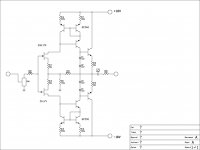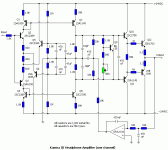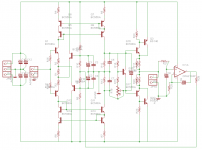Hi,
Well i know a similar topology has been used open loop as a phono amp. It occoured to me it may make a reasonable line amp either with the gain lowered by current feedback as shown or even open loop with say a diamond buffer in place of the output emitter followers.
Do you have a specific reason for disliking the circuit?
Well i know a similar topology has been used open loop as a phono amp. It occoured to me it may make a reasonable line amp either with the gain lowered by current feedback as shown or even open loop with say a diamond buffer in place of the output emitter followers.
Do you have a specific reason for disliking the circuit?
Last edited:
cascode will improve distortion and power supply rejection. best done with bipolar for highest cmr. -RNM
Thanks, i will add some BJT cascodes to the input fets, biased with LED strings, and give it a try.
It is just that I have never been convinced about the merits of symmetrical designs for audio, or the use of cascodes in them, it seems to me to be a great deal of needles complexity for very dubious benefits.
Symmetry certainly has esthetic appeal but that is all the merit I can see in it.
rcw
Symmetry certainly has esthetic appeal but that is all the merit I can see in it.
rcw
I'd think about the F5 amp, this is somewhat akin...
I'd want to lose the cap coupled output myself.
perhaps a servo or other means to stabilize the DC point.
Also, not sure I want diodes for the biasing string... maybe, but maybe not... people do seem to use them a lot...
Mosfets for the output?
What is the purpose of the current mirror (just asking)?
Also the input pot is drawn backwards...
_-_-bear
PS. did you simulate it yet and see what it specs at?
I'd want to lose the cap coupled output myself.
perhaps a servo or other means to stabilize the DC point.
Also, not sure I want diodes for the biasing string... maybe, but maybe not... people do seem to use them a lot...
Mosfets for the output?
What is the purpose of the current mirror (just asking)?
Also the input pot is drawn backwards...
_-_-bear
PS. did you simulate it yet and see what it specs at?
Hello, Oops!, missed the input pot!
The Wilson current mirrors, just seemes an elegant way of doing things, i have seen very similar topologys with current feedback op amps, though they generaly have BJTs at the input, usually very fast with excellent slew rate.
I did consider the circuit open loop with load reistor from the collectors of the mirrors to ground, omitting the diodes and emiter foillowers, but with an open loop buffer tagged on the end as the line amp will have to drive long cables.
As you say, doide biasing of the output followers is used a lot, i suppose perhaps it does offer a little temperature compensation for the output devices. As for Mosfets, i have never really got to grips with them in low level circuitry.
I have not siimed the circuit.
The Wilson current mirrors, just seemes an elegant way of doing things, i have seen very similar topologys with current feedback op amps, though they generaly have BJTs at the input, usually very fast with excellent slew rate.
I did consider the circuit open loop with load reistor from the collectors of the mirrors to ground, omitting the diodes and emiter foillowers, but with an open loop buffer tagged on the end as the line amp will have to drive long cables.
As you say, doide biasing of the output followers is used a lot, i suppose perhaps it does offer a little temperature compensation for the output devices. As for Mosfets, i have never really got to grips with them in low level circuitry.
I have not siimed the circuit.
Last edited:
It is just that I have never been convinced about the merits of symmetrical designs for audio, or the use of cascodes in them, it seems to me to be a great deal of needles complexity for very dubious benefits.
Symmetry certainly has esthetic appeal but that is all the merit I can see in it.
rcw
Lower distortion is one reason..... I did a headphone amp (see this forum) with symetrical circuit and got well below -100dB harmonics. Symetrical is best circuit to use for highest performance in audio -- IMO. -RNMarsh
I am not convinced by the distortion argument.
I can't seem to find the headphone amplifier that you refer to but I can almost invariable use the number of active devices such symmetrical circuits use in a asymmetrical one with better performance.
This thread is about an amplifier with ten transistors and a proposal to add more.
You can make a better amplifier that has d.c. stability and high psrr with the same number of transistors and it also has better distortion figures, that uses the much maligned global feedback.
Local only feedback is certainly useful in wide-band high frequency amplifiers as is symmetry but unless you are talking about more than several mega Hertz global feedback gives better results.
rcw
I can't seem to find the headphone amplifier that you refer to but I can almost invariable use the number of active devices such symmetrical circuits use in a asymmetrical one with better performance.
This thread is about an amplifier with ten transistors and a proposal to add more.
You can make a better amplifier that has d.c. stability and high psrr with the same number of transistors and it also has better distortion figures, that uses the much maligned global feedback.
Local only feedback is certainly useful in wide-band high frequency amplifiers as is symmetry but unless you are talking about more than several mega Hertz global feedback gives better results.
rcw
I like cascode stages and I can understand some PSSR improvement but isn't there so little signal modulation on the drains that a cascode won't reduce distortion (significantly) or is the intent to allow operating at a different more optimal drain bias voltage?
Thanks
-Antonio
Thanks
-Antonio
Hi
My main concern regarding cascode of the input fets, is the effect of the fets non linear input capacitance.
My main concern regarding cascode of the input fets, is the effect of the fets non linear input capacitance.
A cascode wont change the modulation on the gs capacitance and it still appears to me that with the relatively low impedance seen by the drain that the dg capacitance does not get much signal modulation. That is, there is no gain multiplication of the dg capacitance. The fet has a fair drain bias on it resulting in a low and relatively linear dg capacitance.
Hope this helps
-Antonio
Hope this helps
-Antonio
Use 2sk246 and 2sj103 and read Borbely jfet article link below. The 2SJ103 cascodes the 2SJ74 same way the 2SK246 cascodes the 2SK170. Low parts count and works well.
JFETs the New Frontier
JFETs the New Frontier
Last edited:
Thanks for the link, yes i have read that article, and did consider the 2SK246/103 as cascodes. But i would prefer a little more overhead voltage on the input fets, i am sure i read, though i cant recall where, that the 2sk170/J74 perform better with a higher ds voltage than provided by the simple FET/FET cascode.
I will probably just stick a couple of bipolar cascodes on the input fets, just to be on the safe side.
I did find this: Voltage Amplifier & Current Buffer DIY
which is pretty similar to what i had in mind, for an open loop version.
Cheers.
I will probably just stick a couple of bipolar cascodes on the input fets, just to be on the safe side.
I did find this: Voltage Amplifier & Current Buffer DIY
which is pretty similar to what i had in mind, for an open loop version.
Cheers.
- Status
- Not open for further replies.
- Home
- Source & Line
- Analog Line Level
- Jfet Line preamp, to cascode or not.


